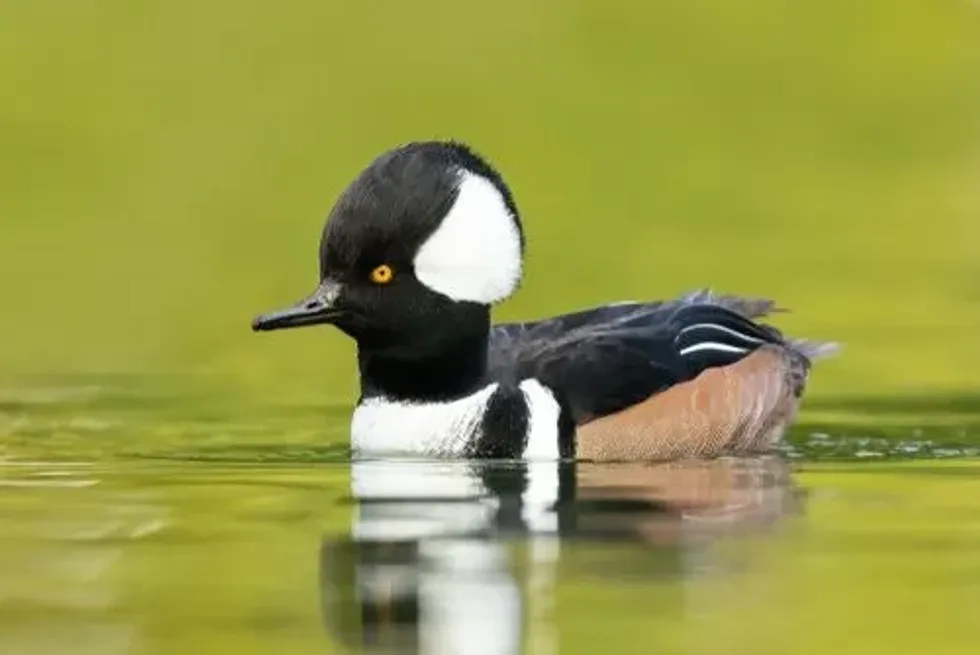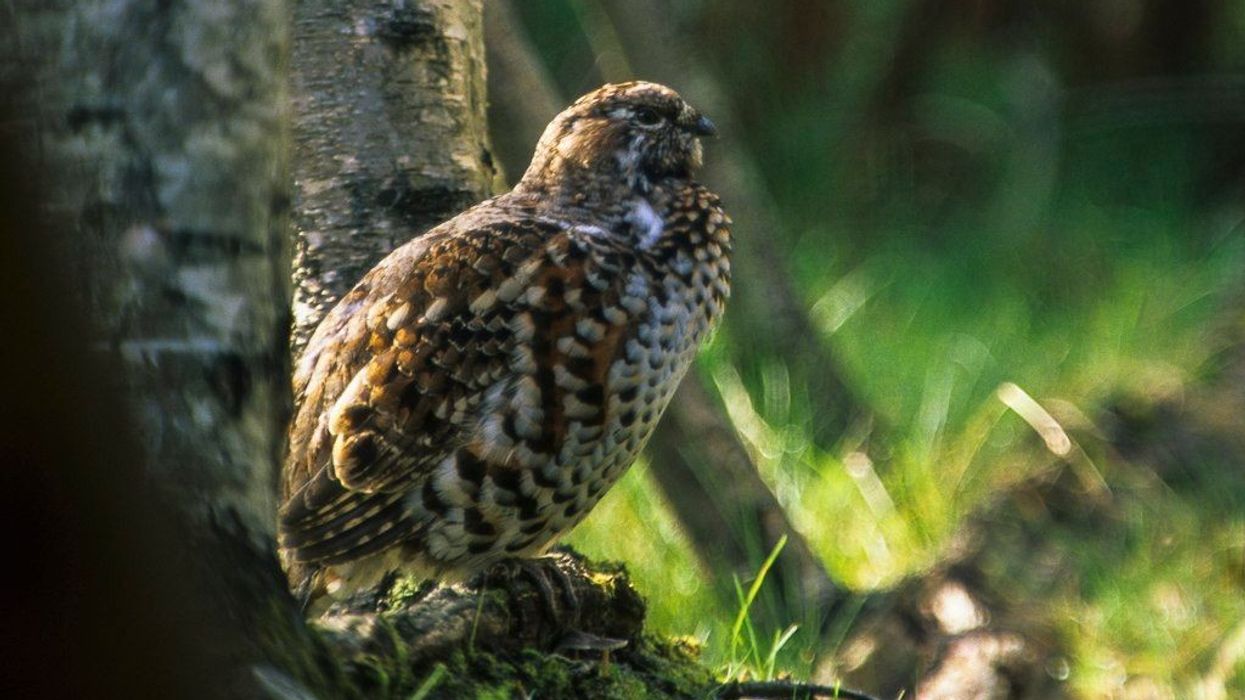A native of North America, the hooded merganser (Lophodytes cucullatus) is known to be the smallest duck among all the three merganser species. They are unique for their preying skills that require diving into the water and chasing fish for up to two minutes.
They are adept at both flying and swimming. Unlike most other ducks, their diet consists mainly of fish.
The hooded merganser duck has a beautiful appearance and is unique in its nature. These ducks have a 'nictitating membrane' that is used while diving underwater.
The 'nictitating membrane' is an additional set of eyelids that acts as a protective shield, just like swimming goggles. The population of these wild ducks is increasing due to their brilliant survival techniques.
Although these ducks are North-American birds, their habitat is not restricted to North America only. They are also found in Canada, the Pacific Coast, Ohio river valley, New England, Gulf Coast, Baja, and some surrounding states.
If you found these hooded merganser facts intriguing then continue reading. Also, if you love to read about various bird species then check out laughing gulls and frigates.
Hooded Merganser Interesting Facts
What type of animal is a hooded merganser?
The hooded merganser is a duck.
What class of animal does a hooded merganser belong to?
The hooded merganser belongs to the class of birds, that is, Aves.
How many hooded mergansers are there in the world?
There are innumerable hooded mergansers across the world and their population is on a rise with each passing day. The exact number is unknown due to the lack of data.
Where does a hooded merganser live?
Hooded mergansers lives in small water bodies like streams, ponds, lakes, swamps, marshy areas, and rivers. It is known to live in the wilderness of North America.
What is a hooded merganser's habitat?
A hooded merganser's habitat is mainly the forested wetlands, bodies with fresh water like ponds, lakes, marshes, swamps, streams, rivers, and other similar small water bodies. However, their habitat is not restricted as they migrate and fly off to nearby locations during harsh winters.
Who do hooded mergansers live with?
Hooded mergansers are not solitary birds as they stick to their flock during the seasons of spring and fall. During the span between spring and fall, they can be found in small ponds or lakes with other species of ducks (like ruddy ducks).
The females and males also stick together through the breeding period. However, these ducks normally do not live in human company but rather in the midst of nature.
How long does a hooded merganser live?
On average, the lifespan of a hooded merganser ranges from 11-12 years in the wild.
How do they reproduce?
After selecting partners following courtship, the males and females move about in monogamous pairs all through the breeding season. A male bird sticks with the female and accompanies her on her search for the perfect nest boxes.
The male leaves only after the female is safely settled in her nesting space where she goes through incubation. Generally, a hooded merganser hen chooses the nesting area for laying eggs that is close to a water body.
The females have an incubation period of 26-41 days after conception. After incubation, when the eggs hatch and the ducklings are born, the females do not leave their nest boxes. Rather they care for the immature hooded merganser ducklings.
The clutch size consists of up to 13 eggs. After the eggs hatch, the ducklings need little maternal care.
What is their conservation status?
As per the International Union for Conservation of Nature, hooded mergansers fall under the category of species listed as Least Concern. Their conservation status reveals that they are available in abundance and are not at all rare. The species is not likely to perish or get affected in the current times owing to its non-vulnerable status.
Hooded Merganser Fun Facts
What do hooded mergansers look like?

The males and the females of the species show dimorphism in their appearance as well as behavior. The male birds look attractive with a beautiful fan-shaped crest and black bodies with white marks.
They also have white spots on both sides of the crest. On the other hand, the female birds of the hooded merganser family have a duller grayish-brown color. A male bird has yellow eyes whereas a female possesses brown eyes.
How cute are they?
Hooded mergansers are very cute in their appearance. Female hooded merganser comes in a duller shade when compared with a hooded merganser drake but their ducklings are extremely adorable.
How do they communicate?
Hooded mergansers generally do not engage in too much interaction as they prefer to remain in calm and composed solitude throughout the day. However, they do communicate while hunting or courting.
While hunting, they interact by croaking or grunting in a low tone.
On the other hand, when these birds have to please their female counterparts, the males give out a rolling sound.
This deep sound is often compared to the sounds emitted by the pickerel frogs due to which these ducks are also called 'frog duck' by the inhabitants of Georgia.
However, unlike several other species of birds, a hooded merganser call is not shrill or unbearably loud except when they make the rolling sound that is audible from a great distance.
How big is a hooded merganser?
Normally, the length of hooded merganser ranges from 15.8-19.3 in (40-49 cm) and it is the smallest among the merganser species. However, they are comparatively larger than the bufflehead ducks.
How fast can a hooded merganser fly?
Hooded mergansers can achieve an approximate speed of 50 mph (80 kph) while in flight. They are exceptional fliers as well as swimmers.
How much does a hooded merganser weigh?
On average, the weight of hooded merganser ranges between 16-31 oz (454-879 g). While the males come with a weight near 24 oz (680 g) or above, the females weigh comparatively low around 19 oz (540 g).
What are their male and female names of the species?
A hooded merganser female is referred to as a hen while a hooded merganser male is referred to as a drake.
What would you call a baby hooded merganser?
A baby hooded merganser is commonly called a duckling. They are also be referred to as hooded merganser chicks.
What do they eat?
The hooded mergansers are essentially carnivores feeding mostly on fish. However, a hooded merganser diet also consists of mollusks, tadpoles, frogs, clams, crabs, crayfish, crustaceans, and aquatic insects. Mergansers are the only species of the duck family to have a specialized fish diet.
Are they friendly?
Hooded mergansers form pairs during the breeding season. They can also be found mixing with other species of ducks. Also, these ducks are not known to portray aggressiveness towards humans although they might not prefer to live in their company. It can be said that they exhibit a friendly nature.
Would they make a good pet?
Hooded mergansers are best if left in their natural habitat. Although they have a calm nature and often live in flocks, it is not known if they would make good pets. Their behavior in the company of human beings needs speculation.
Did You Know...
The pronunciation of hooded merganser is 'hu-duhd mr-gan-sr'. The term 'merganser' derives its meaning from German roots. The species has been named after their genus, that is, 'Lophodytes' where 'lophos' means crest while 'dutes' implies diver.
These ducks have a crest that is collapsible and while flattering a female bird, the males raise their crest in excitement.
These ducks are renowned for their diving skills and catching prey from underwater. Therefore, they can stay submerged for quite a long time. They can stay underwater for about two minutes. Even humans cannot hold their breath underwater for such a long time!
Have you ever heard a hooded merganser's sound? The hoarse rolling, frog-like sound implies that a hooded merganser duck is nearby, engaged in courtship.
Do you know that a bufflehead and hooded merganser share a lot of similarities while they are also dissimilar in a lot of ways? Then let's go for a bufflehead vs hooded merganser!
Firstly, the former is smaller in size. Secondly, the bufflehead males have white-colored sides while the hooded mergansers are cinnamon-colored. Finally, the latter comes with a slender bill.
A juvenile hooded merganser is capable of catching its prey (with the guidance of the mother) just half an hour after hatching!
Sometimes hooded merganser decoys are set up by the hunters to trap these beautiful ducks just for keeping them as a prize. These decoys were mainly used to attract the ducks by misleading them.
However, in modern times, these practices have been banned and have become obsolete with the introduction of duck farming. Hooded merganser taxidermy is also popular for decoration and educational purposes. They are widely available in markets and make for beautiful home decor.
It is not uncommon to walk into a high-end restaurant and find duck meat on its menu. Several species of the duck family like the Pekin duck, moulard duck, muscovy duck, or other farm-grown ducks make their way to the platter.
However, mergansers are generally avoided mainly because of their strong flavor (as they feed mainly on fish).
There have been speculations and experiments to see if hooded merganser meat is palatable or not. If the majority of opinions and responses are to be taken then these ducks are best when left off the table as they do not taste good.
What is another name for hooded mergansers?
The hooded merganser is also called hooded sheldrake. It is also called a fish duck because of its specialized fish diet. These ducks are even referred to as frog ducks due to the long guttural sound that they make. You can hear this long and deep sound from up to half a mile away.
How high above the ground can hooded mergansers nest?
Hooded merganser flying at great heights for nesting is not an uncommon sight. These ducks normally look for cavities in trees or previously made nest boxes, made preferably out of wood shavings. They can fly up to 90 feet for nesting in a safe place.
Here at Kidadl, we have carefully created lots of interesting family-friendly animal facts for everyone to discover! Learn more about some birds, including the crested duck and the Muscovy duck.
You can even occupy yourself at home by drawing one of our duck coloring pages.










